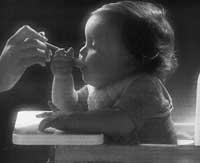Every disease has its remedy
Hiccups, hangover and vomiting are common disorders, especially in childhood, which often result in a certain severity, since it is not easy to find its causes to remedy. Let's look at each of these three situations: how to interpret these problems, what parents should do, etc.
Hypo
Zotin is a very common reaction, especially in infants. And what causes hiccups? Today it is assumed that it is due to the contraction of the diaphragm, which is the contraction of the large horizontal muscle that separates the abdominal and pectoral organs. This muscle has a lot to do with the two children who form breathing (inspiration or inspiration, expiration or expiration), and when the hiccups appear, it can be prolonged (up to the hour) without causing excessive discomfort to the child.
Why does the zotin appear?
A child may get some milk from the stomach into the esophagus after taking the breast, undigested milk, slightly golden or slightly bitter milk. This milk stimulates some nerve endings found in the esophagus mucosa, starting the reflex. In children who resonate more than normal this fact is very common, but also in the rest of the “normal” children.
And what to do to solve this situation?
At this point they will recommend a lot of “remedies” to a more nervous than nervous parent: to give a few drops of lemon to the child, others will tell him to give warm water again in small arches or to put something hot on the stomach. But we will all have to agree that we never have to take hard procedures such as:
- keep the child's nose closed for a few seconds
- Scare the child until he stops breathing!
Remember that hiccups are an ephemeral event that disappears after the first distress and almost never bothers the child too much. As a last suggestion or suggestion, Hippocrates recommended the relaxation of the diaphragm against hiccups through the corso or sneezing. But how to get the child “atxis”? Tickling your nose, for example with a pen.
Regurgitation

Although the name is quite unknown to many readers, the concept itself is better known: who has not seen a healthier child, who after breastfeeding has a small leak of milk between the lips? That's regurgitation: immediately after taking the breast, or between two shots, or even a little before the next take the child throws small amounts of milk through the mouth.
Depending on the time the segmentation and regurgitation occurs, the milk that is expelled by the mouth will have some characteristics or others: the later the berramurallamiento occurs (for the reference of the intake, of course), the milk will be more digested, that is, the milk will have a consistency similar to cheese and more acid.
What are the reasons for this recovery?
If during the first few months the door or passage between the esophagus and the stomach is not mature enough, the milk can go back through the passage of the so-called “door” and causing a resurgence. If these are very numerous and occur many times a day, it is advisable to inform the pediatrician. It can be a situation known as “gastro-erophageal reflux” because the cardia is too open, so the acid content of the stomach will reach through the esophagus to the mouth.
When the child is a few months old, the main cause of recovery is the baby's ingestion of air during breastfeeding. The air will be expelled by corrosion and with it the milk.
What measures can we take as prevention?
- When we tilt the bottle down, that the drops of milk do not fall in the form of a tap, it is easy but not too much.
- When the child is drinking the bottle, it must be folded correctly: thus, the nipple will always be full of milk. If not, the child would ingest the air and once mixed in the stomach with milk, both would be expelled at the same time at the time of running.
- When breastfeeding the child (and also if we give the bottle), if possible, keep the child sitting or quite up and not lying down: in this way, the milk, heavier than the air, will go to the bottom of the stomach.
- Finally, when the child is taking (both the chest and the bottle) does not shake too much, or become nervous, to prevent more air in the stomach than when sucking normally.
Vomiting
Vomiting would consist of throwing milk (or other liquid, but this time we will only talk about milk) into the mouth in large amounts. It occurs when the abdominal muscles and diaphragm contract sharply.
* What are the reasons for the climb?
They can be many. Normally, when vomiting is isolated there is no reason to worsen. Vomiting will be caused by another disorder (e.g., otitis media or upper respiratory infection) and vomiting will go away as the cause goes away.
On other occasions, however, vomiting is usually violent and abundant as a jet, as is the case with gastroenteritis. In this case, after a few days and with the recovery of the cause, vomiting will disappear.
In newborns, fortunately in very rare cases, they can be symptoms of piloroesfenosis, that is, the narrowness of the stomach “passage door”. In this case, milk barely flows through the stomach and eventually tends to spread stomachs. And because the stomach muscles cannot overcome the obstacle of pyloric strangulation, they contract by pushing the milk hard into the mouth. In this case surgery is the only solution and the pediatrician will be the most suitable person to advise and advise.
* What can you do?
Once the cause of vomiting is known, the pediatrician will indicate the most appropriate treatment. As a general rule, we must remind our readers (and more now, when we have the heat of summer on top) that there is the “risk of dehydration”. And this risk is even more serious in young children, when vomiting also accompany diarrhea. Therefore, the child always has liquids at hand (in this case the mouth).
Buletina
Bidali zure helbide elektronikoa eta jaso asteroko buletina zure sarrera-ontzian










